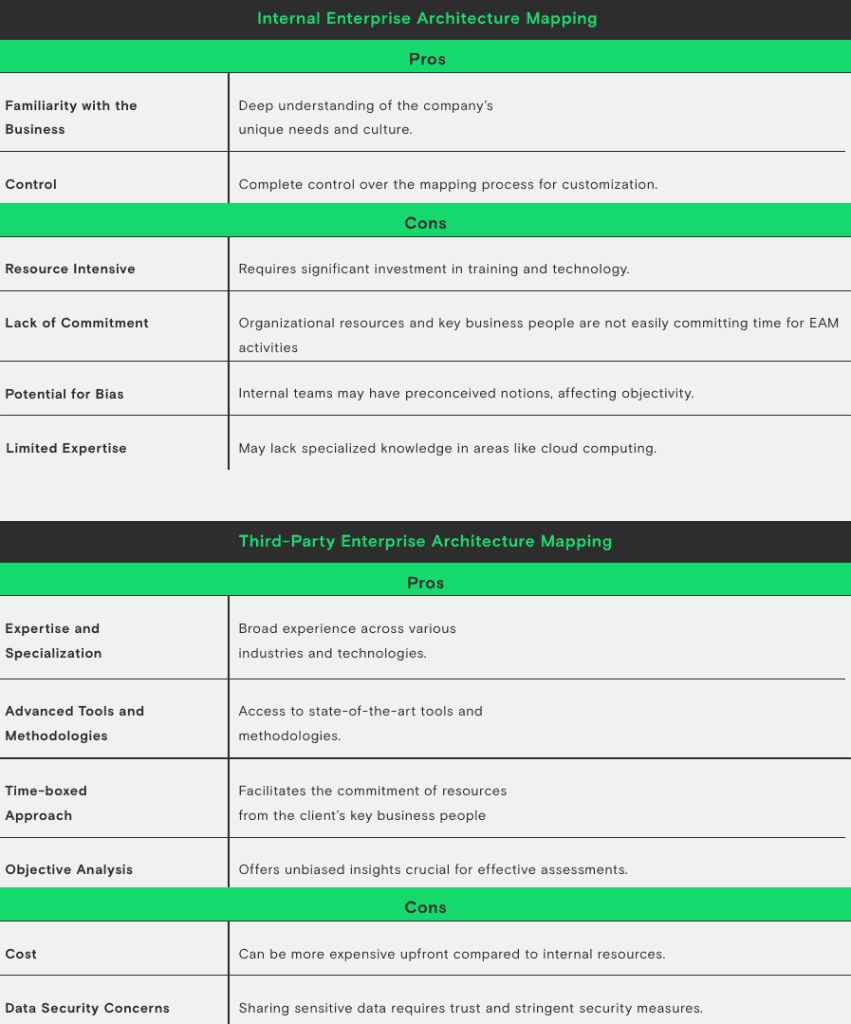Choosing the Right Path:
Internal vs Third-Party Enterprise Architecture Mapping
In an era where digital transformation projects are reshaping the corporate landscape, aligning IT infrastructure with business goals has become more crucial than ever. This alignment, an intricate part of Enterprise Architecture (EA), plays a pivotal role in various strategic initiatives, from cloud migration to mergers & acquisitions. As businesses invest heavily in technology, the need for specialized services in Enterprise Architecture Mapping has become apparent.
Overview of Enterprise Architecture Mapping
Defining Enterprise Architecture Mapping
Enterprise Architecture Mapping is a strategic process that aligns an organization’s application/technology/infrastructure landscape with its business objectives. It involves creating a series of comprehensive visualization artifacts or catalogues that depict the interrelations and dependencies among various applications and systems. This process not only supports software engineering and maintenance but also aids in significant decision-making during technology investments and enterprise architecture risk assessments.
Control your Enterprise Architecture
Enterprise Architecture Mapping (EAM) follows a multi-faceted approach. It begins with an in-depth analysis of the organization’s IT environment. This analysis encompasses a thorough enterprise architecture risk assessment, ensuring any weaknesses are identified and addressed. The result is a series of enterprise architecture visualization artifacts that offer a clear, actionable view of an organization’s application and technology landscape.
The methodology employed in such an initiative is both robust and adaptable, integrating best practices in software architecture with cutting-edge tools. The emphasis on application dependencies and application visualization ensures that organizations can navigate complex cloud computing environments and digital transformation initiatives more effectively. By providing a detailed map of the enterprise’s architecture, EAM features empower organizations to make informed decisions, optimize their IT investments, and foresee the implications of potential changes in their infrastructure.
Use Case: Gaining Full Visibility into IT Operations
To contextualize the efficacy of Enterprise Architecture Mapping, let us consider the use case of a leading international organization embarking on a significant digital transformation project. Faced with a sprawling, opaque application and technology landscape, the company struggled with siloed information and a lack of comprehensive visibility, which hindered its cloud migration efforts and made technology investments riskier.
The intervention of a specialized Enterprise Architecture Mapping service provider marks a turning point. The provider conducted an exhaustive enterprise architecture risk assessment, uncovering hidden dependencies and potential bottlenecks. Utilizing sophisticated application visualization tools, the provider developed an extensive enterprise architecture visualization artifact that mapped out the entire IT landscape.
The benefits were manifold. The organization gained a clear, holistic view of its applications and infrastructure, instrumental in its digital transformation journey. This newfound clarity facilitated more strategic decision-making, better allocation of resources for software maintenance, and a smoother cloud migration process. Additionally, the detailed insight into their application dependencies and infrastructure paved the way for more effective integration during subsequent mergers and acquisitions.
Comparing Internal vs Third-Party Enterprise Architecture Mapping
When it comes to implementing Enterprise Architecture Mapping, organizations face a critical decision: should they manage it internally or partner with a third-party service provider? Both approaches have their merits and drawbacks.
To aid in this decision, the following table compares the pros and cons of each approach:

Internal Enterprise Architecture Mapping
Pros
Familiarity with the
Business
Business
Control
Deep understanding of the company’s
unique needs and culture.
unique needs and culture.
Complete control over the mapping process for customization.
Cons
Resource Intensive
Lack of Commitment
Potential for Bias
Limited Expertise
Requires significant investment in training and technology.
Organizational resources and key business people are not easily committing time for EAM activities
Internal teams may have preconceived notions, affecting objectivity.
May lack specialized knowledge in areas like cloud computing.
Third-Party Enterprise Architecture Mapping
Pros
Expertise and
Specialization
Specialization
Advanced Tools and Methodologies
Broad experience across various
industries and technologies.
industries and technologies.
Access to state-of-the-art tools and
methodologies.
methodologies.
Time-boxed
Approach
Approach
Objective Analysis
Facilitates the commitment of resources
from the client’s key business people
from the client’s key business people
Offers unbiased insights crucial for effective assessments.
Cons
Cost
Data Security Concerns
Can be more expensive upfront compared to internal resources.
Sharing sensitive data requires trust and stringent security measures.
Making the decision about choosing the most suitable option – internal or third-party – necessitates the consideration of many factors:
- Availability of internal resources.
- Enterprise architecture complexity.
- Internal knowledge and expertise.
- Ongoing business initiatives, including digital transformation projects or mergers & acquisitions.
- Context driving the use of Enterprise Architecture Mapping artifacts.
- The pros and cons of each option.
Choosing a Third-Party Enterprise Architecture Mapping Provider
Selecting the right third-party provider is crucial for the success of your Enterprise Architecture Mapping initiative. Here are key considerations and characteristics to look for:

Considerations for Selection
Experience and
Track Record
Track Record
Compatibility with Existing Systems
Look for providers with proven experience in your industry and
a portfolio of successful projects.
a portfolio of successful projects.
The provider should be able to integrate seamlessly with your current application/technology/infrastructure landscape.
Methodological
Approach
Approach
Security and
Compliance
Compliance
Evaluate the provider’s methodology to ensure it aligns with your organization’s needs, particularly in areas like cloud computing and software maintenance.
Ensure the provider adheres to stringent data security protocols and compliance standards.
Customer Support
and SLAs
and SLAs
Good customer service and clear service-level agreements are essential for a fruitful partnership.
Characteristics of an Ideal Provider
Expertise in Digital Transformation
Tools and Technology
Providers should have a strong record of guiding organizations from multiple sectors through digital transformation projects.
Access to advanced tools for enterprise architecture visualization and analysis.
Customization and
Flexibility
Flexibility
Strategic Insight
Ability to tailor their services
to your specific needs.
to your specific needs.
Not just technical expertise but the ability to provide strategic advice on technology investments and future IT planning.
Conclusion
Enterprise Architecture Mapping is pivotal in today’s rapidly evolving digital landscape. While internal solutions have their place, the complexity and scope of modern IT environments often necessitate the expertise, tools, and objectivity that a third-party provider brings. By carefully selecting a partner who not only understands the intricacies of software architecture but also aligns with your business objectives, you can ensure a successful digital transformation, efficient cloud migration, and robust preparation for mergers & acquisitions.
As you consider enhancing your enterprise architecture, remember that the right partnership can be the catalyst for achieving not just operational excellence but also long-term strategic success.
